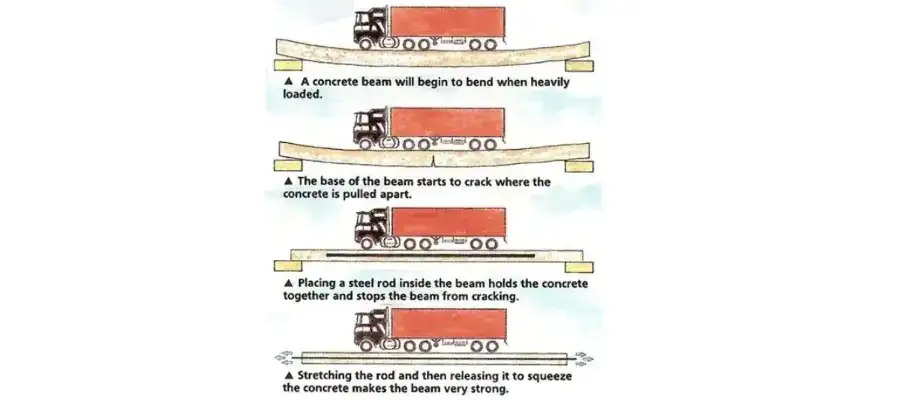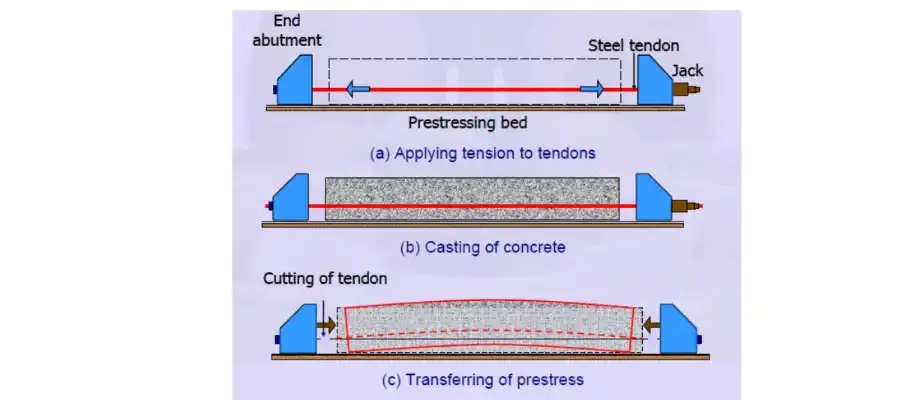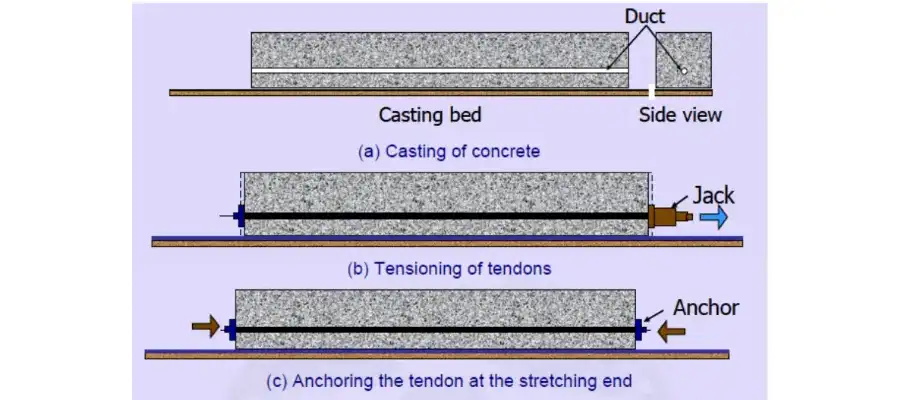We know that concrete plays an incredible role in construction because of its adaptability and stability. However, basic traditional concrete structures can’t handle heavy loads or long spans. To overcome this issue, engineers developed prestressed concrete, combining concrete and steel’s strengths. As a result, prestressed concrete has become a crucial construction material. This article explains the prestressed concrete process, its benefits, and its applications.
What is Prestressed Concrete?
Prestressed concrete works by combining the hard nature of concrete and durable nature of steel. To make it, steel wires are tightly pulled and surrounded by concrete. After hardening, the steel is released, squeezing the concrete. This creates a powerful bond, boosting strength and durability. Thus, prestressed concrete supports massive weights and spans vast distances, perfect for constructing bridges, highways, and massive buildings.
Why is Prestressed Concrete Required?
Tensile strength is important in building materials because it prevents cracking and deformation. This ability allows materials to withstand heavy stresses and loads. However, concrete, despite its strength, lacks tensile strength, making it prone to cracking. To achieve tensile strength in concrete, prestress is created using steel bars. Consider a bridge made with a traditional concrete mix; without sufficient compression, it cannot withstand the pressure of heavy vehicles, leading to cracking. By incorporating steel, which provides tensile strength, massive support is added.

Image Source: williams-works
How Does Pre-Stressed Concrete Work?
Though prestressed concrete involves complex processes, it has transformed the construction industry. By combining the science of tension and compression, prestressed concrete creates structures that boast enhanced strength and durability. Let’s see how it works.
The Prestressed Concrete Process:
Fabrication: Steel tendons (wires and cables) are manufactured and prepared.
Concrete Pouring: Concrete is poured around the tendons, enclosing them.
Tensioning: Tendons are pulled and stretched using hydraulic jacks.
Anchoring: Tendons are secured to the concrete to maintain the tension.
Relaxation: Tendons relax, transferring pressure to the concrete.
Compression: Concrete is compressed, increasing its strength.
This is a simple science behind how prestressed concrete works. When the pressure in the tendons is released, it converts into a compressive force within the concrete, preventing cracking and deformation. Consequently, the concrete develops the capacity to resist tensile forces and withstand heavy loads.
How to Implement Prestressed Concrete?
Before implementing prestressed concrete, it is essential to make accurate calculations and have a proper design plan. Afterwards, the site should be well-prepared to carry out the process. Tendons initiate the prestressed concrete process. However, the transfer of compressive force from tendons to concrete can occur in two ways: pre-tensioning and post-tensioning. Here’s what distinguishes them in the process.
| Pre-Tensioning | Post-Tensioning |
| Tensioning occurs before concrete pouring | Tensioning occurs after concrete has set |
| Suitable for small spans and repetitive structures | Suitable for long spans and complex geometries |
| Tendons are placed directly in formwork | Tendons are placed in ducts within concrete |
| Lower equipment costs and less labour | Higher equipment costs and more labour |
| Used in precast components (roofs, floors, walls), foundation piles | Used in long-span bridges, skyscrapers and infrastructures in seismic zones |

Image Source: williams-works

Image Source: williams-works
Benefits of Prestressed Concrete
Structural Integrity
Prestressed concrete has much higher strength and durability due to its inner forces acting against outer loads. This enables the concrete to be highly resistant to cracks and fractures, thereby ensuring the structure’s longevity. Moreover, prestressed concrete features an improved load-carrying capability, lowers deflection, and has greater resistance in earthquake-prone areas and wind loads.
Streamlined Construction
The use of prestressed concrete significantly accelerates construction timelines. By minimising formwork and falsework, contractors can optimise site efficiency. Additionally, prestressed concrete components are lighter and easier to handle, reducing transportation costs and enhancing site safety. This streamlined process also leads to lower labour costs.
Environmental Sustainability
Prestressed concrete promotes environmental responsibility by reducing material waste and energy consumption. Its sustainable material options and reduced carbon footprint contribute to an eco-friendlier built environment. Moreover, prestressed concrete improves indoor air quality, creating healthier spaces.
Economic Advantages
By optimising material usage, prestressed concrete achieves cost savings. Its extended lifespan (50-100 years) and reduced maintenance requirements translate to lower lifecycle costs. Additionally, prestressed concrete reduces structural weight, enhancing resale value.
Aesthetic Appeal
Prestressed concrete gives sleek, smooth finishes and thinner slabs and walls, increasing design flexibility. This results in improved natural lighting and enhanced architectural appeal.
Durability and Resilience
Prestressed concrete resists chemical attacks, exhibits improved fire resistance and reduces noise transmission. Its enhanced thermal mass and structural resilience ensure long-term performance.
Additional Benefits
Beyond its primary advantages, prestressed concrete offers secondary benefits, including resistance to pests and decay, reduced shrinkage, and enhanced weather resistance. These added benefits further qualify prestressed concrete as a premier building material.
Advantages of Prestressed Concrete
- Prestressed concrete achieves higher strength using minimal materials, resulting in lighter structures.
- It can span up to 20 meters, making it suitable for long spans without intermediate supports. Therefore, prestressed concrete is ideal for bridges, highways, and stadiums.
- Prestressed concrete minimises lateral deformation by up to 50% due to its enhanced strength.
- It resists cracking and prevents water passage, which helps prevent corrosion. Its overall performance provides longevity to structures.
- Prestressed concrete can withstand repeated stress over time without failing.
- Prefabricated components of prestressed concrete speed up construction work.
- It provides fire resistance for up to 4 hours and superior sound insulation, reducing noise transmission.
Disadvantages of Prestressed Concrete
- The main disadvantage of prestressed concrete is that it requires high-quality equipment and a complex initial setup, increasing the initial investment.
- Improperly placed or unprotected anchors can lead to corrosion and prestress loss.
- Prestressed concrete also demands specialised engineers and skilled labourers, escalating labour costs.
- It is hard to alter or modify any structures in the prestressed concrete due to the intricate placement of tendon and anchorages.
Materials of Prestressed Concrete as per IS Standards
| Cement | OPC 53 grade, OPC 43 grade, and OPC 33 grade, Rapid hardening Portland cement, Portland slag cement, Portland Pozzolana cement, Hydrophobic cement, Low heat Portland cement, Sulphate resisting Portland cement. (any of these cement types can be used but should conform to IS standards) |
| Mineral Admixtures | Pozzolana, Fly ash, Silica Fume, Rice husk ash, Metakaolin, Ground Granulated Furnace Slag (IS 456) |
| Aggregates | 20 mm aggregate is suitable (IS 1343) |
| Water | Water used for mixing and curing shall be clean and free from injurious amounts of oils, acids, alkalis, salts, sugar, organic materials or other substances that may be deleterious to concrete or steel (IS 456)Potable water is considered for mixing concrete |
| Prestressing steel | Plain hard-drawn steel wire, Indented Wire, High tensile steel bar, Uncoated stress relieved strand (IS 1343) |
| Concrete Grade | Should be minimum of M-30 for Post-tensioning and M-40 for Pre-tensioning (IS 1343) |
Conclusion
To conclude, prestressed concrete has emerged as an innovative building method, renowned for its enhanced stability and durability. Its unique characteristics enable it to withstand heavy loads and provide stable structures, making it ideally suited for complex building structures, bridge construction, and multi-level buildings. Following established standards for materials and procedures is crucial to reach its full potential and maximise strength.
FAQs
Prestressed concrete applies compressive force via prestressing techniques, enhancing its load-bearing capacities beyond traditional concrete methods.
It allows for longer spans, thinner structures, and reduced material use, facilitating innovative architectural designs.
The main disadvantages include high initial cost, dependence on skilled labour, and challenges in modifications.
Generally, it can last up to 50-100 years and beyond if properly maintained.
Yes, damages in the prestressed concrete can be repaired by specialized techniques.

